This is another nothing dish but a perfect drinking snack.
I often make microwaved sakamushi (酒蒸しsake steamed) chicken breast. This is very handy to have around. You can make all kinds of small dishes and even sandwiches with it. I usually cook it with the skin on because it keeps the breast meat from getting dry while cooking. When I use the meat, I usually remove the skin before slicing the chicken but I do not discard the skin. Instead I leave it in the container with the remaining meat and chicken juice. I use the same technique with raw chicken. When I remove the skin, I sometimes discard it but other times I prepare small dishes from the skin. If I am preparing the chicken skin from scratch, I prepare it by first boiling in water with sake, scallion and ginger added. But when I am using the skin of sakamush chicken, I need not to do these preparations.
Unfortunately, chicken skin has a layers of fat attached to it. I removed the fat with a knife as much as I could before slicing it into thin strips. I also sliced the scallions, which were cooked with the chicken breast, on the bias about the same size and length of the skin. I mixed and dressed them with ponzu shouuyu (pozu wih soy sauce). I also grated some daikon 大根 and squeesed out the excess moisture.
To assemble, I sliced some cucumber (American minicucumber) and fanned out the pieces putting them on one side of the plate (in this case, I used a lacquered square ichi-go masu sake measuring cup 一合升) . I placed a small mound of grated daikon next to the slices. Then place the dressed chicken skin and scallion next to the daikon and cucumber. For slight heat, I sprinkled on 7 flavored Japanese red pepper flakes or shichimi tougrashi 七味唐辛子.
Saturday, June 16, 2012
Tuesday, June 12, 2012
Pennsylvania Dutch Pepper Slaw ペンシルバニアダッチペッパースロー
This is a taste from my wife’s childhood. So, she is writing this blog.

After we made the traditional mayonnaise based American coleslaw several days ago, I remembered there was another type of coleslaw that was always present at picnics in my childhood. I remembered it was called pepper slaw. My husband had never heard of it, so I decided to make it for him.
All the vegetables are cut into a fine dice so the pieces are all about the same size. They include: 1 head of cabbage, 7 stalks of celery, one red and one yellow bell pepper with the skin removed, one purple or sweet onion. Mix the cut vegetables together in a large bowl. As usual, my husband sliced and diced so efficiently and quickly, this is the easiest part of the preparation for me. He referred to himself as the human “cuisinart”, but the mileage may differ depending of what you have.
Dressing: 1/2 cup sugar, 1 cup sushi vinegar, 2 tsp. salt, 2 tsp mustard seed bloomed (to bloom the mustard seed put into a dry frying pan and heat until the seed pops open. When they start popping they will look like popcorn hopping out of the pan. Take them off the heat immediately. Blooming the seeds gives them a much richer flavor). The other ingredients include 3/4 to 1 tsp. black pepper, 1/2 tsp Dijon mustard and 1 tsp celery seed.
Pour the dressing over the vegetables and stir completely. Let the slaw rest in the refrigerator for several hours for the flavors to marry. This will get better over the next few days. The dressing I use includes much less sugar than the traditional recipes. The inclusion of sushi vinegar is not traditional either, but It is much milder than the usual cider vinegar. In addition, I added more cracked black pepper than the usual recipes call for. (With these traditional dishes there must be regional differences. The pepper slaw I grew up with was really quite peppery. I thought it was called pepper slaw because of the sharp spicy black pepper taste. This is what I grew up with and this is what I expect from the dish. You may want to vary the amount of pepper to your own taste). It wasn’t until we were making this batch that my husband pointed out that the inclusion of the red (green, yellow, orange etc) peppers contributed to the name pepper slaw as well.
I have not eaten this dish in years. As a child it was my least favorite slaw but it was ubiquitous--no picnic was complete without mayo based coleslaw and pepper slaw. I thought it was basically coleslaw with a lot of black pepper added. Again I am amazed how a taste can transport you to a different time and place. When I initially tasted the mixture I made, I thought it was close but didn’t really ring a bell. It wasn’t until I started dialing up the amount of black pepper that I reached a point when suddenly the taste was exactly what I remembered. Also, I have to say I appreciate this dish much more as an adult than I did as a kid. It is sweet and sour, with a spiciness that is very refreshing.
P.S. I find I keep adding cracked black pepper to this dish...it still has not reached the level pepperiness I remember.

After we made the traditional mayonnaise based American coleslaw several days ago, I remembered there was another type of coleslaw that was always present at picnics in my childhood. I remembered it was called pepper slaw. My husband had never heard of it, so I decided to make it for him.
All the vegetables are cut into a fine dice so the pieces are all about the same size. They include: 1 head of cabbage, 7 stalks of celery, one red and one yellow bell pepper with the skin removed, one purple or sweet onion. Mix the cut vegetables together in a large bowl. As usual, my husband sliced and diced so efficiently and quickly, this is the easiest part of the preparation for me. He referred to himself as the human “cuisinart”, but the mileage may differ depending of what you have.
Dressing: 1/2 cup sugar, 1 cup sushi vinegar, 2 tsp. salt, 2 tsp mustard seed bloomed (to bloom the mustard seed put into a dry frying pan and heat until the seed pops open. When they start popping they will look like popcorn hopping out of the pan. Take them off the heat immediately. Blooming the seeds gives them a much richer flavor). The other ingredients include 3/4 to 1 tsp. black pepper, 1/2 tsp Dijon mustard and 1 tsp celery seed.
Pour the dressing over the vegetables and stir completely. Let the slaw rest in the refrigerator for several hours for the flavors to marry. This will get better over the next few days. The dressing I use includes much less sugar than the traditional recipes. The inclusion of sushi vinegar is not traditional either, but It is much milder than the usual cider vinegar. In addition, I added more cracked black pepper than the usual recipes call for. (With these traditional dishes there must be regional differences. The pepper slaw I grew up with was really quite peppery. I thought it was called pepper slaw because of the sharp spicy black pepper taste. This is what I grew up with and this is what I expect from the dish. You may want to vary the amount of pepper to your own taste). It wasn’t until we were making this batch that my husband pointed out that the inclusion of the red (green, yellow, orange etc) peppers contributed to the name pepper slaw as well.
I have not eaten this dish in years. As a child it was my least favorite slaw but it was ubiquitous--no picnic was complete without mayo based coleslaw and pepper slaw. I thought it was basically coleslaw with a lot of black pepper added. Again I am amazed how a taste can transport you to a different time and place. When I initially tasted the mixture I made, I thought it was close but didn’t really ring a bell. It wasn’t until I started dialing up the amount of black pepper that I reached a point when suddenly the taste was exactly what I remembered. Also, I have to say I appreciate this dish much more as an adult than I did as a kid. It is sweet and sour, with a spiciness that is very refreshing.
P.S. I find I keep adding cracked black pepper to this dish...it still has not reached the level pepperiness I remember.
Saturday, June 9, 2012
Blanched Mizuna 水菜のおひたし
Mizuna 水菜 is a Japanese green, sometimes called Japanese mustard green, which is often used in a Japanese hot pot dish or “Nabe” 鍋. It has a very subtle piquant flavor. The other day, we were in the near-by Japanese grocery store and, somehow, I thought, I picked up a package of edible chrysanthemum or shungiku 春菊 but when I opened it several days later, I discovered it was Mizuna. My wife, who likes edible chrysanthemum, was disappointed. Since I was not planning on making a nabe dish, I made this simple but a classic “ohitashi” dish.

“Ohitashi” means “soaked”. Originally, vegetables (mostly leafy greens) were boiled and then “soaked” in a broth or dashi 出汁. The excess liquid was then squeezed out and it was seasoned with soy sauce. More commonly, however, the soaking step was omitted and the boiled leafy vegetable with soy sauce on top is called “Ohitashi”.
Mizuna: One package of mizuna was composed of about 6 individual plants measuring about 12 inches long. As with any leafy vegetable, it looked like a lot but after cooking the volume decreased quite a bit. I washed the stalks and lined them up so that all the leafy parts were on one side and the root ends on the other. I cut off the root end and cut the remainins stalks in half so that one bunch was mostly leafy and the other was mostly stalks.
I first cooked the stalks in salted boiling watr for 30-40 seconds and then added and cooked the leafy part for another 30 seconds. I drained the cooked greens in the colander. Spread the cooked mizuna flat and cooled it down by fanning. You could shock it in ice cold water but this is easier and the mizuna will not get too watery.
Dressing: Instead of “broth” which may have been used in the original form of “ohitashi”, I made mustard/soy sauce mixture or “karashi shouuyu” 芥子醤油. I put about 1/2 tsp of Japanese hot mustard (from a tube), sugar (1/4 tsp) and soy sauce (2 tsp) in a Japanese mortar or “suribachi” すり鉢 and mixed all together using a pestle or “surikogi” すりこ木.
I squeezed out any excess moisture from the cooked mizuna and then cut into pieces about 2 inch long. I dressed with the above karashi shouuyu. I placed it in a small dish as seen above. I garnished with dried bonito flakes “Katsuobushi” 鰹節 (pre-shaven and came in a small plastic pouch). Just before eating, you may want to moisten the bonito flakes with a bit of additional soy sauce (which we did).
This is more for the texture than the taste of the green itself but, nevertheless, very refreshing small dish which can go well with your Japanese style dinner/breakfast or drinking snack. “Ohitashi” can be made any vegetables but the most common is using spinach. When using spinach, especially the Japanese variety, you should soak the spinach in cold water after boiling to remove oxalic acid.

“Ohitashi” means “soaked”. Originally, vegetables (mostly leafy greens) were boiled and then “soaked” in a broth or dashi 出汁. The excess liquid was then squeezed out and it was seasoned with soy sauce. More commonly, however, the soaking step was omitted and the boiled leafy vegetable with soy sauce on top is called “Ohitashi”.
Mizuna: One package of mizuna was composed of about 6 individual plants measuring about 12 inches long. As with any leafy vegetable, it looked like a lot but after cooking the volume decreased quite a bit. I washed the stalks and lined them up so that all the leafy parts were on one side and the root ends on the other. I cut off the root end and cut the remainins stalks in half so that one bunch was mostly leafy and the other was mostly stalks.
I first cooked the stalks in salted boiling watr for 30-40 seconds and then added and cooked the leafy part for another 30 seconds. I drained the cooked greens in the colander. Spread the cooked mizuna flat and cooled it down by fanning. You could shock it in ice cold water but this is easier and the mizuna will not get too watery.
Dressing: Instead of “broth” which may have been used in the original form of “ohitashi”, I made mustard/soy sauce mixture or “karashi shouuyu” 芥子醤油. I put about 1/2 tsp of Japanese hot mustard (from a tube), sugar (1/4 tsp) and soy sauce (2 tsp) in a Japanese mortar or “suribachi” すり鉢 and mixed all together using a pestle or “surikogi” すりこ木.
I squeezed out any excess moisture from the cooked mizuna and then cut into pieces about 2 inch long. I dressed with the above karashi shouuyu. I placed it in a small dish as seen above. I garnished with dried bonito flakes “Katsuobushi” 鰹節 (pre-shaven and came in a small plastic pouch). Just before eating, you may want to moisten the bonito flakes with a bit of additional soy sauce (which we did).
This is more for the texture than the taste of the green itself but, nevertheless, very refreshing small dish which can go well with your Japanese style dinner/breakfast or drinking snack. “Ohitashi” can be made any vegetables but the most common is using spinach. When using spinach, especially the Japanese variety, you should soak the spinach in cold water after boiling to remove oxalic acid.
Thursday, June 7, 2012
Coleslaw コールスロー
On Memorial day weekend, my wife wanted to have coleslaw to usher in the start of summer. In Japanese-Western dishes or "Yoshoku" 洋食 such as tonkatsu トンカツ, shredded raw cabbage is the most favorite accompaniment but my wife in general is not a fan of cabbage particularly shredded raw cabbage. I usually end up disguising the cabbage with some type of dressing. This time, she wanted classic unadulterated American style coleslaw—we’re talking the start of the summer season after all.

By her direction, I played the role of a human cuisine art and sliced cabbage, carrot in thin strips and finely diced red onion for her. The amount is arbitrary but we used 7-8 leaves of cabbage, with thick veins removed and thinly sliced, and two medium carrots, thinly sliced on the bias and then finely julienned. She also added 1/2 cup of raisins in a large bowl as you see below.

Dressing: There are many variations but below is what she used.
Mayonnaise 1/2 cup
Plain yogurt 1/2 cup
Red onion 1 small, finely chopped
Sushi vinegar 1 Tbs.
Worcestershire sauce 1 tsp
Sugar 1/4 tsp
Kosher salt 1/2 tsp
Ground black pepper to taste
She dressed the coleslaw and let it sit in the refrigerator for, at least, several hours, before serving. The slaw will get better next day. This is near-classic American coleslaw and it was ridiculously good. I have to admit, even for me, I would rather eat this than just shredded raw cabbage. The finely chopped sweet red onion is what made the dish. Also, even though this type of coleslaw is usually made with a dressing of mayonnaise, the addition of the yogurt makes the dressing more healthy but oddly enough none of the mayo flavor is lost.

By her direction, I played the role of a human cuisine art and sliced cabbage, carrot in thin strips and finely diced red onion for her. The amount is arbitrary but we used 7-8 leaves of cabbage, with thick veins removed and thinly sliced, and two medium carrots, thinly sliced on the bias and then finely julienned. She also added 1/2 cup of raisins in a large bowl as you see below.

Dressing: There are many variations but below is what she used.
Mayonnaise 1/2 cup
Plain yogurt 1/2 cup
Red onion 1 small, finely chopped
Sushi vinegar 1 Tbs.
Worcestershire sauce 1 tsp
Sugar 1/4 tsp
Kosher salt 1/2 tsp
Ground black pepper to taste
She dressed the coleslaw and let it sit in the refrigerator for, at least, several hours, before serving. The slaw will get better next day. This is near-classic American coleslaw and it was ridiculously good. I have to admit, even for me, I would rather eat this than just shredded raw cabbage. The finely chopped sweet red onion is what made the dish. Also, even though this type of coleslaw is usually made with a dressing of mayonnaise, the addition of the yogurt makes the dressing more healthy but oddly enough none of the mayo flavor is lost.
Tuesday, June 5, 2012
Beef back rib BBQ on Memorial day 牛バックリブのバーベキュー
On Memorial day, we like to barbecue particularly if the weather allows. We tend to be in a rut and cook whole chickens served with sides of potato and macaroni salads. We have done roast pork, beef, lamb etc and wanted to do something different this year. So we cooked beef back rib this year.
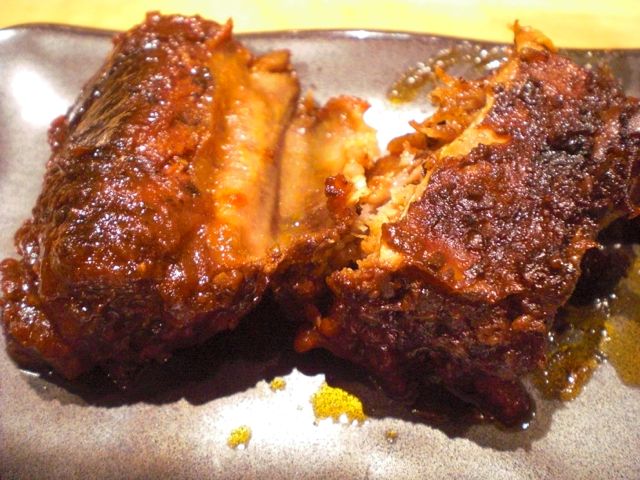
We fired up two Weber kettles. One was used for baking pizzas and the other was used to cook the ribs. Oh, we also made teba gyoza. The answer to my wife’s question how many wings can I prepare and cook one time; twelve! (see below).

I removed the wingtips to save space on the grill. I ended up cooking the teba gyoza in two batches but if we were not cooking the ribs, I could have cooked all 12 at once. I did not take a picture of the final and cooked teba gyoza but it is the same as before but lacking the handle (i.e. wingtips) to hold onto.
The recipe for the ribs is based on ones listed in the Weber webpage.
Ribs: I got center back ribs (with 6 ribs). I removed excess fat and rubbed the dry rub below I placed the ribs in the Ziploc bag and refrigerated for 8 hours.
Dry rub: Dried oregano (2 tsp), smoked paprika (2 tsp), dried granulated onion (2 tsp), brown sugar (1 tsp), kosher salt (1 tsp), and ground black pepper (1 tsp).
Barbecue sauce: Initially I was to use store bought Mango BBQ sauce (which had been given to us sometime ago) but, upon tasting, I decided it was too sweet and my wife decided to make her own BBQ sauce. Here is the recipe my wife made which is a “classic” ketchup based sauce. Her recipe is based on one in “Joy of Cooking” but with her own variations. It is also very similar to the one used in pork spare rib.
For the sauce; Two medium onions were coarsely diced and sauteed in a small amount of olive oil until soft and caramerized (15-20 minutes). One cup of ketchup was added to the pan and cooked, scraping the bits left behind from cooking the onions, until the sugar in the ketchup was caramelized (the color will change from red to more dull brownish color). Combine, the onion and the ketchup in a sauce pan with a mixture of rice vinegar (2 tbs), water (1/2 cup), lemon (1/4 cup), paprika powder (1/2 tsp), Worcestershire sauce ( 1 tbs), salt (1 tsp), brown sugar (1 tbs) and mustard (1 tbs.) and simmer for about 15 minutes. I added about ½ cup of red wine (since we did not have wine which did not pass our Wednesday wine drinkability criteria - lowest-, we used one we will be drinking in the near future) to the sauce and simmered it for 5-6 minutes and kept it warm.
I took the ribs from the refrigerator 30 minutes before cooking to come to room temperature. I prepared the grill for indirect heat and added soaked apple wood chips for smoking. Using the direct heat part of the grill, I seared both side 5-6 minutes each. I then transfer the ribs (I had to cut it in half) to a Pyrex baking dish and poured the wine/BBQ sauce mixture over the ribs and covered it tightly with aluminium foil. I placed it in the indirect heart area and further cooked it for 1 more hour (see picture below).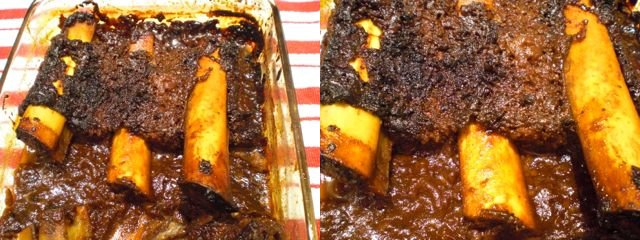
As you can see the sauce reduced and the meat was almost coming off the bones. It is usual to serve it with the bone on, but the meat just came of the bone as I was serving. So I just served the meat sans (without) bone (the first picture).
 We are not connoisseurs of BBQ as they are in the South and Texas, but we thought these were mighty good ribs with BBQ sauce. The sauce; caramelized with the juice from the meat was just the right consistency--ooey-gooey, mildly smokey sweet and sour. The meat had a nice crust and melted in your mouth. We had our usual macaroni salad (Memorial day would not be Memorial day without that) with the addition of black bean corn salad. But this combined with the pizza, and the chicken wings--which had to be tasted as they came off the grill, of course, was way too much food.
We are not connoisseurs of BBQ as they are in the South and Texas, but we thought these were mighty good ribs with BBQ sauce. The sauce; caramelized with the juice from the meat was just the right consistency--ooey-gooey, mildly smokey sweet and sour. The meat had a nice crust and melted in your mouth. We had our usual macaroni salad (Memorial day would not be Memorial day without that) with the addition of black bean corn salad. But this combined with the pizza, and the chicken wings--which had to be tasted as they came off the grill, of course, was way too much food.
As and antidote/libation, we chose shiraz from Maclaren valley, Australia called Clarendon Hills McLaren Valley Piggott Range Vineyard, Syrah 2005. This is a very nice heavy duty shiraz. It stood up against the strong flavorof the BBQed ribs. This one got 97 from Wine Advocate.
We fired up two Weber kettles. One was used for baking pizzas and the other was used to cook the ribs. Oh, we also made teba gyoza. The answer to my wife’s question how many wings can I prepare and cook one time; twelve! (see below).
I removed the wingtips to save space on the grill. I ended up cooking the teba gyoza in two batches but if we were not cooking the ribs, I could have cooked all 12 at once. I did not take a picture of the final and cooked teba gyoza but it is the same as before but lacking the handle (i.e. wingtips) to hold onto.
The recipe for the ribs is based on ones listed in the Weber webpage.
Ribs: I got center back ribs (with 6 ribs). I removed excess fat and rubbed the dry rub below I placed the ribs in the Ziploc bag and refrigerated for 8 hours.
Dry rub: Dried oregano (2 tsp), smoked paprika (2 tsp), dried granulated onion (2 tsp), brown sugar (1 tsp), kosher salt (1 tsp), and ground black pepper (1 tsp).
Barbecue sauce: Initially I was to use store bought Mango BBQ sauce (which had been given to us sometime ago) but, upon tasting, I decided it was too sweet and my wife decided to make her own BBQ sauce. Here is the recipe my wife made which is a “classic” ketchup based sauce. Her recipe is based on one in “Joy of Cooking” but with her own variations. It is also very similar to the one used in pork spare rib.
For the sauce; Two medium onions were coarsely diced and sauteed in a small amount of olive oil until soft and caramerized (15-20 minutes). One cup of ketchup was added to the pan and cooked, scraping the bits left behind from cooking the onions, until the sugar in the ketchup was caramelized (the color will change from red to more dull brownish color). Combine, the onion and the ketchup in a sauce pan with a mixture of rice vinegar (2 tbs), water (1/2 cup), lemon (1/4 cup), paprika powder (1/2 tsp), Worcestershire sauce ( 1 tbs), salt (1 tsp), brown sugar (1 tbs) and mustard (1 tbs.) and simmer for about 15 minutes. I added about ½ cup of red wine (since we did not have wine which did not pass our Wednesday wine drinkability criteria - lowest-, we used one we will be drinking in the near future) to the sauce and simmered it for 5-6 minutes and kept it warm.
I took the ribs from the refrigerator 30 minutes before cooking to come to room temperature. I prepared the grill for indirect heat and added soaked apple wood chips for smoking. Using the direct heat part of the grill, I seared both side 5-6 minutes each. I then transfer the ribs (I had to cut it in half) to a Pyrex baking dish and poured the wine/BBQ sauce mixture over the ribs and covered it tightly with aluminium foil. I placed it in the indirect heart area and further cooked it for 1 more hour (see picture below).
As you can see the sauce reduced and the meat was almost coming off the bones. It is usual to serve it with the bone on, but the meat just came of the bone as I was serving. So I just served the meat sans (without) bone (the first picture).
As and antidote/libation, we chose shiraz from Maclaren valley, Australia called Clarendon Hills McLaren Valley Piggott Range Vineyard, Syrah 2005. This is a very nice heavy duty shiraz. It stood up against the strong flavorof the BBQed ribs. This one got 97 from Wine Advocate.
97 Points - Wine Advocate
Deep crimson in color with mineral notes, violets, spice box, black pepper, espresso, smoked game, and blueberry aromatics. Deceivingly opulent, it has enough structure to merit 8-10 years of cellaring and should make old bones. Drink it through 2035."
Sunday, June 3, 2012
Pizza BBQed in Weber kettle ピッザバーベキュー
Although I generally don't do anything particularly extraordinary, it appears, based on the reaction of my dinner guests, that my pizza is not bad, decent pizza. They appear to really like it and some have even been unabashed in trying to emulate what I do. (I suppose this is an ultimate flattery--which I fully support by coaching them in achieving good results). As I posted before, I use a hot oven with a pizza stone but for some time I’ve wanted to make pizza in the Weber kettle. I bought a pizza stone for the Weber more than 1 year ago but I did not have a chance to try it until this Memorial day.
I decided to make a pizza Marguerite as shown below.

Mine is very basic without any special ingredients. The amount here is more than enough to make two pizzas (about 8 inch in diameter). I first added light olive oil (4 tbs) in a pan on low flame. I then add chopped garlic (3 fat cloves, finely chopped) and let it fry slowly for several minutes or until fragrant but not browned. I added one can of whole Italian tomatoes with its juice (cut into small chunks, 15 oz). I seasoned it with dried oregano (1/2 tsp), dried basil (1/2 tsp), black pepper, and salt. I simmered it for about 1 hour with a lid off (left upper in the image below). I made a sauce dry without any extra moisture (right upper in the image below).

: There are quite a few different types of Pizza stones for grills being sold. What I got is semicircular shaped which fits into the 22.5 inch Weber Kettle perfectly and the bottom cutout precisely corresponds with the grill's hinged grate so that you could add coals and wood chips during the cooking. It came with instructions but I could not find them. So I used my common sense but obviously some more refinement is required to perfect pizza made on the Weber grill as you can see below. I prepared the lump hardwood charcoal using a Although I generally don’t do anything particularly extraordinary, it appears, based on the reactions of my dinner guest’s that my pizza is not bad chimney starter as usual. I spread the hot coals in the bottom of the grill, placed the grate and the pizza stone over them. I let the stone warm up with the lid on for 30 minutes. Just before putting on the pizza, I threw in apple wood chips soaked in water.
Dough: This is my usual pizza dough. I proof the yeast by dissolving yeast (1 package) in ⅕ cup lukewarm water with a pinch of sugar. After 5 minutes, the mixture got bubbly indicating good vigorous yeast. I added cold water to make it to 1 cup. In a food processor with a dough blade, I added bread flour (3 and ¼ cup) and salt (1/2 tbs). While on low speed, I drizzled olive oil (2 tbs) and then 1 cup of water and the yeast mixture. I watched until a dough ball formed on the blade and added a little more water (2-3 more tbs). I stopped the blade and touched the dough to make sure the dough was soft and slightly sticky. I let it sit for 5 minutes to distribute the water evenly. I turned on the food processor on low speed for 30 seconds or so. I dumped out the dough on a well floured board and kneaded for 5 minutes until the dough was nicely elastic and the surface was smooth. I sprayed the inside of a one-gallon size Ziploc bag with PAM and placed the dough inside and squeezed out the air as much as you could and sealed it shut. I let it raise for 1-2 hours on the counter top (the volume doubles). After deflating the dough, I divided it into 4 and made small balls. I let it rest for 5-10 minutes so that the dough will relax. I made it to a 8 inch round by stretching the dough (first the edge of the dough and then center which was repeated).
Cheese: For one pizza, I used fresh Mozzarella (high moisture content) and for another smoked one with low moisture content. Both are sliced but not shredded.
Assembly and baking for the first pizza: I first placed the stretched dough on wooden pizza peel which is covered with cornmeal. I brushed the dough with garlic infused olive oil (finely chopped garlic placed in olive oil. You should do this just before baking pizza. If you keep garlic under the oil too long, you may risk botulism). I first placed the slices of fresh Mazzerella cheese on top of the dough followed by my tomato sauce. I put the cheese next to the crust and the sauce on top of the cheese for several reasons. First it provides a barrier between the crust and the moisture of the sauce preventing the crust from becoming soggy. Second, if the cheese is put on top of the sauce the molten cheese sometimes slides off the pizza like a magma flow while you’re trying to eat the slice because the sauce underneath provides no traction for the weight of the cheese on top (common among chain-store pizzas). I slid the dough with the topping directly on the top of the stone (image above), closed the lid and baked it for 7-8 minutes.
Assembly and baking for the second pizza: For this one, I first baked the dough blank on the stone (This is what I do if I am not using the stone) for 3-4 minutes or until the bottom of the dough was firm and the surface started puffing up. I flipped it over and place the sliced smoked Mazzerella cheese and spread the tomato sauce on the top. I closed the lid and let it bake for another 5 minutes.
For both pizza, after baking, I grated Parmigiano-Reggiano cheese on the top and garnished it with chiffonade of fresh basil (top picture).
Well, both were more than edible but not my best. The bottom got a bit high-done on the first one--it was quite crispy but basically carbonized. The second one was much better. I may have to do some rearranging to the charcoal next time; maybe using semi-indirect heat. Both pizzas, did not have the wood smoke flavor I was expecting. I may have to add more wood chips and few minutes before baking pizza especially since the pizza does not stay in the Weber for long. But with a good red wine, the pizza was great. After two pizzas, I also baked a blank dough brushed with olive oil and torn leaves of fresh rosemary from our herb garden with some kosher salt sprinkled on after baking. This makes a sort of thin crunchy foccasia bread. Of course, we did not finish the pizza especially since we also cooked teba gyoza and beef back rib. The leftover pizza re-heated well in the toaster oven on ensuing weekday evenings which was a wonderful appetiser to come home to after a hard day of work.
Mine is very basic without any special ingredients. The amount here is more than enough to make two pizzas (about 8 inch in diameter). I first added light olive oil (4 tbs) in a pan on low flame. I then add chopped garlic (3 fat cloves, finely chopped) and let it fry slowly for several minutes or until fragrant but not browned. I added one can of whole Italian tomatoes with its juice (cut into small chunks, 15 oz). I seasoned it with dried oregano (1/2 tsp), dried basil (1/2 tsp), black pepper, and salt. I simmered it for about 1 hour with a lid off (left upper in the image below). I made a sauce dry without any extra moisture (right upper in the image below).
: There are quite a few different types of Pizza stones for grills being sold. What I got is semicircular shaped which fits into the 22.5 inch Weber Kettle perfectly and the bottom cutout precisely corresponds with the grill's hinged grate so that you could add coals and wood chips during the cooking. It came with instructions but I could not find them. So I used my common sense but obviously some more refinement is required to perfect pizza made on the Weber grill as you can see below. I prepared the lump hardwood charcoal using a Although I generally don’t do anything particularly extraordinary, it appears, based on the reactions of my dinner guest’s that my pizza is not bad chimney starter as usual. I spread the hot coals in the bottom of the grill, placed the grate and the pizza stone over them. I let the stone warm up with the lid on for 30 minutes. Just before putting on the pizza, I threw in apple wood chips soaked in water.
Dough: This is my usual pizza dough. I proof the yeast by dissolving yeast (1 package) in ⅕ cup lukewarm water with a pinch of sugar. After 5 minutes, the mixture got bubbly indicating good vigorous yeast. I added cold water to make it to 1 cup. In a food processor with a dough blade, I added bread flour (3 and ¼ cup) and salt (1/2 tbs). While on low speed, I drizzled olive oil (2 tbs) and then 1 cup of water and the yeast mixture. I watched until a dough ball formed on the blade and added a little more water (2-3 more tbs). I stopped the blade and touched the dough to make sure the dough was soft and slightly sticky. I let it sit for 5 minutes to distribute the water evenly. I turned on the food processor on low speed for 30 seconds or so. I dumped out the dough on a well floured board and kneaded for 5 minutes until the dough was nicely elastic and the surface was smooth. I sprayed the inside of a one-gallon size Ziploc bag with PAM and placed the dough inside and squeezed out the air as much as you could and sealed it shut. I let it raise for 1-2 hours on the counter top (the volume doubles). After deflating the dough, I divided it into 4 and made small balls. I let it rest for 5-10 minutes so that the dough will relax. I made it to a 8 inch round by stretching the dough (first the edge of the dough and then center which was repeated).
Cheese: For one pizza, I used fresh Mozzarella (high moisture content) and for another smoked one with low moisture content. Both are sliced but not shredded.
Assembly and baking for the first pizza: I first placed the stretched dough on wooden pizza peel which is covered with cornmeal. I brushed the dough with garlic infused olive oil (finely chopped garlic placed in olive oil. You should do this just before baking pizza. If you keep garlic under the oil too long, you may risk botulism). I first placed the slices of fresh Mazzerella cheese on top of the dough followed by my tomato sauce. I put the cheese next to the crust and the sauce on top of the cheese for several reasons. First it provides a barrier between the crust and the moisture of the sauce preventing the crust from becoming soggy. Second, if the cheese is put on top of the sauce the molten cheese sometimes slides off the pizza like a magma flow while you’re trying to eat the slice because the sauce underneath provides no traction for the weight of the cheese on top (common among chain-store pizzas). I slid the dough with the topping directly on the top of the stone (image above), closed the lid and baked it for 7-8 minutes.
Assembly and baking for the second pizza: For this one, I first baked the dough blank on the stone (This is what I do if I am not using the stone) for 3-4 minutes or until the bottom of the dough was firm and the surface started puffing up. I flipped it over and place the sliced smoked Mazzerella cheese and spread the tomato sauce on the top. I closed the lid and let it bake for another 5 minutes.
For both pizza, after baking, I grated Parmigiano-Reggiano cheese on the top and garnished it with chiffonade of fresh basil (top picture).
Well, both were more than edible but not my best. The bottom got a bit high-done on the first one--it was quite crispy but basically carbonized. The second one was much better. I may have to do some rearranging to the charcoal next time; maybe using semi-indirect heat. Both pizzas, did not have the wood smoke flavor I was expecting. I may have to add more wood chips and few minutes before baking pizza especially since the pizza does not stay in the Weber for long. But with a good red wine, the pizza was great. After two pizzas, I also baked a blank dough brushed with olive oil and torn leaves of fresh rosemary from our herb garden with some kosher salt sprinkled on after baking. This makes a sort of thin crunchy foccasia bread. Of course, we did not finish the pizza especially since we also cooked teba gyoza and beef back rib. The leftover pizza re-heated well in the toaster oven on ensuing weekday evenings which was a wonderful appetiser to come home to after a hard day of work.
Wednesday, May 30, 2012
Baked shiitake mushroom stuffed with pork 椎茸の豚肉詰めオーブン焼き
This is a dish I made from the leftover gyoza stuffing from making teba gyoza 手羽餃子. I happened to have fresh large shiitake mushrooms (about 3 inch diameter) and decided to stuff them with the gyoza stuffing and bake them. This is a variation of the dish I posted before. Becase the mushrooms were very large and meaty, this dish came out very well. I again, served this with a side of Sriracha hot sauce.
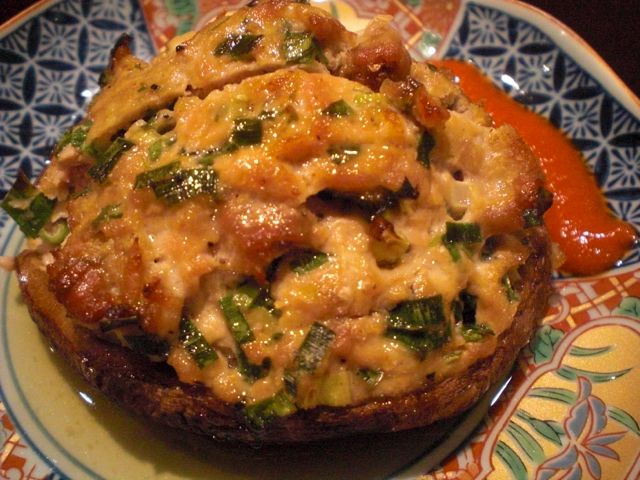
Pork stuffing: I used up a bit over half of the gyoza stuffing left over from making the teba gyoza.

I baked them in a 400F toaster oven for 30 minutes (right upper and left lower in the image above). Some juice, which was nicely seasoned, came out. I cut the stuffed mushrooms in half showing the bottom shiitake and top gyoza stuffing (right lower in the above image).
I served this with some of the juice accumulated in the bottom of the baking dish and a side of Sriracha hot sauce. The shiitake mushrooms gave a nice meaty texture which soaked up the meat juice. This is a very satisfying dish.
Pork stuffing: I used up a bit over half of the gyoza stuffing left over from making the teba gyoza.
Shiitake mushroom: I found these large fresh mushrooms in our near-by gourmet grocery store a few days ago and bought them thinking I would make some kind of stuffed and baked dish. I washed and removed the stem and squeezed out the extra moisture. I put a small amount of olive oil in the cap (which was promptly absorbed) and simply stuffed the caps with the gyoza mixture (left upper in the image blow).
I baked them in a 400F toaster oven for 30 minutes (right upper and left lower in the image above). Some juice, which was nicely seasoned, came out. I cut the stuffed mushrooms in half showing the bottom shiitake and top gyoza stuffing (right lower in the above image).
I served this with some of the juice accumulated in the bottom of the baking dish and a side of Sriracha hot sauce. The shiitake mushrooms gave a nice meaty texture which soaked up the meat juice. This is a very satisfying dish.
(A few days later we made a meal by combining several of these left over stuffed mushrooms with the barbecued gyoza chicken wings--it was a mighty fine combination).
Although this will go with any drinks, we were having this with an interesting Sonoma red blend called "The Barrister 2010". They equate this to Orin-Swift "The prisoner", which we rather liked (I am not sure the "Barrister" was so named because they were comparing this wine to the "Prisoner" and indicating "barrister" is better than "prisoner"???). This is a red made of many varietals but the kitchen sink. Although I could not find what kinds of grapes were in it, we definitely tasted and smelled black pepper indicating a good amount of syrah component. This is a good food wine and great with the this dish.
Monday, May 28, 2012
"Teba gyoza" stuffed chicken wings, baked and BBQed 手羽餃子オーブン焼きとバベキュー
Sometime ago when I posted "Teba Gyoza" 手羽餃子, which was deep fried, I promised that I would try baking or grilling it to see what happens. Finally I had a chance. Here I cooked teba gyoza two ways; the left in the image below was hot smoked/grilled using a Weber kettle and the right baked in a toaster oven.
The version which was hot smoked/grilled in the Weber kettle looked much nicer with its mahogany color, crispy skin and juicy meat stuffing inside with a good smoky flavor (below).
The version which was hot smoked/grilled in the Weber kettle looked much nicer with its mahogany color, crispy skin and juicy meat stuffing inside with a good smoky flavor (below).
The oven baked one was not bad at all either, although it did not look as good and lacked the smoky flavor.
Although the preparation process is almost identical to the previous post, I added more visual aids.
Gyoza stuffing: I did not use boiled shredded cabbage this time. As usual, I made the hand chopped ground pork from the trimmings of two pork tenderloins. This time I weighed the trimmings and they were 12 and 3/8 oz (or about 300 grams). I mixed in garlic chive (from our herb garden, finely chopped, 2 tbs), scallion (finely chopped, 2tbs), ginger (1/2 tsp, grated or from the tube), garlic (1/2 tsp grated or from the tube) salt (1/2 tsp), sesame oil (1-2 tbs), black pepper (1/2 tsp) and soy sauce (1 tsp). I mixed them well by hand until the texture was elastic and holding together (#1 in the image below). Half of this amount was sufficient to stuff 6 wings (i.e. this amount would be sufficient for 12 or more wings).
Preparation of the chicken wings: This is the most tricky step. I started with cutting around the bone (humerus) to separate the meat from the bone (#2). Holding the end of the bone in vertical position, I scraped the meat from the bone until I reached the joint (elbow joint equivalent). During this process, I made sure not to poke any holes into the skin. I then grabbed the bone and, with bending and twisting motions, removed the bone from the joint (#3). Before stuffing, I put my finger into the cavity and separated the skin and and bone as much as I could without breaking the skin and stuffed the cavity with the gyoza mixture (#4).
Using a tooth pick and a sewing motion, I closed the opening (#5). I prepared 6 wings (#6). More than half of the gyoza stuffing remained which will be used for another dish.
Baking: The first day, I baked the wings in a 450F toaster oven for 30 minutes turning them over once after 15-20 minutes.
Hot smoking and grilling: The next day, we barbecued two whole chickens in our usual way. I added teba gyoza to the area of indirect heat and cooked for 30 minutes. I used hickory wood chips soaked in water for hot smoking.
Either way, the teba gyoza were great. They were much better, in fact, than the deep fried ones. The hot smoked version is better in appearance and flavors of the two but the baked one is much easier to cook.
Here is the cross section showing the gyoza stuffing in the baked version. This is a great dish for beer and sake. Since the stuffing is well seasoned, there is no need for a sauce but I served this with a side of Sriracha hot sauce. If you like spicy flavors, this really enhances all the flavor of this dish.
P.S. The leftovers heated up very well in the toaster oven but the difference between the baked and hot smoked versions became more pronounced, i.e., the hot smoked ones were much better or even better than when they were originally cooked since reheating in the toaster oven made the skin really crispy. Now my wife is asking how many wings I can prepare and cook at one time in the barbeque.
Saturday, May 26, 2012
Grilled soft shell crab ソフトシェルクラブの炭焼き
One nice sunny weekend, we stumbled onto a new farmer's market set up in the parking lot of a near-by strip mall. We bought some herbs to plant in our herb garden, nicely sweet and ripe strawberries, hot-house tomatoes (not as good as true summer tomatoes) and a few more items. One of the vendors was a fish monger selling fish from a refrigerated truck. Since they had soft-shell crabs, we could not resist and bought two.
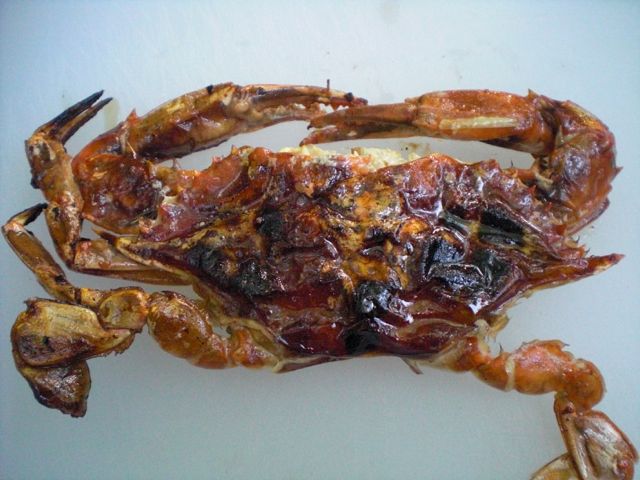
I somehow forgot to put my camera on "macro" mode and all the pictures I took except for the one (above) were out of focus and I cannot show you what the final servings looked like.

As usual, I started lump charcoal in a chimney starter and use our "Yakitori" grill for this. For basting, I made a mixture of melted butter (non-salted) and olive oil (about 1:1). I heated up the butter and olive oil for a few minutes and added finely chopped shallot. I then seasoned it with black pepper, salt, lemon zest and lemon juice and let it cool down to room temperature.
Since it was such a nice sunny day, not too cold not too hot and no overt signs of mosquitos, we really wanted to stay outside. So, we decided to grill the soft-shell crabs instead of cooking them in our usual tempura method.
I brushed the butter mixture on the top side of the crabs and started grilling with the top side down (left in the above picture). After 4-5 minutes when the skin of the crabs turned red and blackend in spots, I basted the underside with the butter mixture and turned it over and cooked another 4-5 minutes (right in the above picture).
Although my picture did not turn out and I cannot show what the final servings looked like, I precut the cooked crabs and served it with grilled asparagus (using the same basting mixture) and grilled tomato halves (skinned, salted and coated with the same butter mixture) and a wedge of lemon. As usual, I also made grilled rice balls as an ending dish with cucumber slices in vinegar dressing with "jako" 胡瓜と雑魚の酢の物.
Although grilled soft-shell crabs are not bad, the skin does not get as crispy as in tempura and we both agreed tempura is the best way to enjoy soft-shell crabs. While edible, the crabs did not entirely meet my wife's standard of freshness, so we will probably not be buying anything else from that vendor. But, at least, we were outside cooking and enjoying the food and wine al fresco.
Thursday, May 24, 2012
Shredded carrot salad with Italian chicken tenderloin 人参のサラダ、鶏の笹身イタリアンソテー
This post is not for the chicken tenders but for the carrot salad which was made by my wife. She made it in a rather large quantity so that we could eat it as a "side" with our lunches during the week at work. She is known to have made shredded carrot salad in the past. It was one of the dishes she served when she first invited me for dinner to her apartment ions ago. Back then she used a blender with a bit of water to shred carrots but now she uses a food processor. As a accompaniment for her carrot salad, I made Italian style chicken tenderloin.
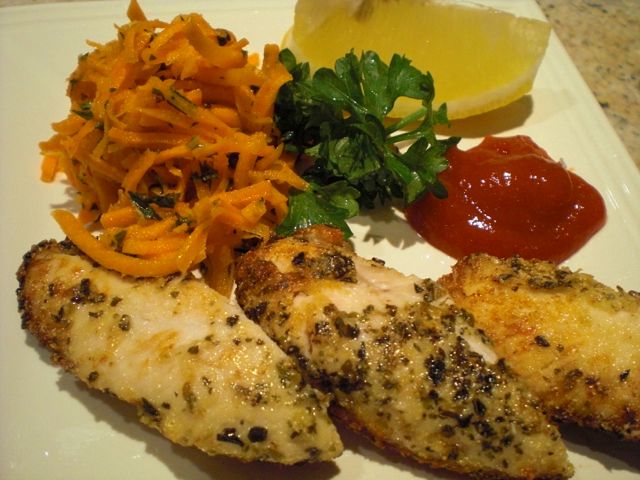
Chicken tenderloin: I used three tenderloins for two small servings. I just seasoned them with salt, pepper, dried basel and oregano. I then dredged in yellow corn meal and fried them in olive oil.
I have to ask my wife to fill in for this quite nice shredded carrot salad.
Again this is a recipe based on the one for spiced carrot salad found in the "500 appetizers" cookbook. As usual we could not resist making variations. I shredded a large bag of carrots in the food processor. (Cook the carrots in batches in the micro wave for 30 seconds, stir and cook about another 30 seconds until the carrots get a bit tender but still have crunch). Then I made a dressing of: 1/2 tsp. ground ginger, 1 tsp. cumin, 1/2 tsp ground coriander, 1/2 tsp paprika, 1/8 tsp cayenne pepper, finely chopped candied ginger to taste, 4 tsp. sushi vinegar, 3 Tbs. olive oil, 2 tsp. chopped mint. I also added about 1 cup of raisins and the juice from 2 limes. I mixed all the spices together with the liquid ingredients and poured the dressing over the carrots and raisins. I let it sit for several hours for the flavors to marry (as a matter-of-fact the salad gets better every day).
I have to ask my wife to fill in for this quite nice shredded carrot salad.
Again this is a recipe based on the one for spiced carrot salad found in the "500 appetizers" cookbook. As usual we could not resist making variations. I shredded a large bag of carrots in the food processor. (Cook the carrots in batches in the micro wave for 30 seconds, stir and cook about another 30 seconds until the carrots get a bit tender but still have crunch). Then I made a dressing of: 1/2 tsp. ground ginger, 1 tsp. cumin, 1/2 tsp ground coriander, 1/2 tsp paprika, 1/8 tsp cayenne pepper, finely chopped candied ginger to taste, 4 tsp. sushi vinegar, 3 Tbs. olive oil, 2 tsp. chopped mint. I also added about 1 cup of raisins and the juice from 2 limes. I mixed all the spices together with the liquid ingredients and poured the dressing over the carrots and raisins. I let it sit for several hours for the flavors to marry (as a matter-of-fact the salad gets better every day).
The sweetness of the carrots combined with the raisins and the dressing make a very sweet/savory combination. Over time the carrots exude juice which blends with the dressing. It is a great way to eat your veggies.
Tuesday, May 22, 2012
Anchovy and black pepper cookies アンチョビ黒胡椒クッキー
One weekend, my wife was looking through a cookbook titled "500 appetizers". She disappeared into the kitchen and came back with "Anchovy and olive tepanade cheese dip". I asked how many anchovies she used knowing how hard it is to use up an entire tin of anchovies. She said the can was empty but I had to wait until tomorrow. The result is shown below. It looks like a perfectly innocent sweet butter cookie but it delivers quite a surprise. It has the texture and crumb of a sugar cookie but it is savory; with the pleasant salty taste of anchovy, pepper and Parmesan cheese. This is certainly not for desert or an afternoon snack but goes surprisingly well with red wine.
I asked my wife for the recipe.

The cookie dough: 1/2 cup all-purpose flour, 1/4 cup butter chilled, 1/3 cup freshly ground Parmesan cheese, 3 anchovies drained, 1/2 tsp. ground black pepper. Process in a food processor until the ingredients come together into a dough. Make into a ball, cover with plastic wrap and refrigerate (my wife chilled it over night). Roll out the dough to about 1/2 inch thick (picture 1) and cut into various shapes with a cookie cutter (picture 2). Put on a lightly greased cookie sheet (picture 3) and bake in a 400 degree oven for about 6 minutes until golden brown (picture 4).
I asked my wife for the recipe.
These are not the cookies to serve with coffee to the bridge club, but as an hors o'dourve accompanied with a full bodied red wine they are very special.
Sunday, May 20, 2012
Cheese dip with anchovy and olive tanpenade アンチョビとオリーブ タンペナーデ ディップ
When I made salt kelp cream cheese dip, we were quite impressed with how well the salty kelp flavor went with the cream cheese. When my wife saw the recipe for this cream cheese based olive tanpenade in the "500 Appetizers" cookbook, she must have thought this would compete well with the salt kelp cream cheese.
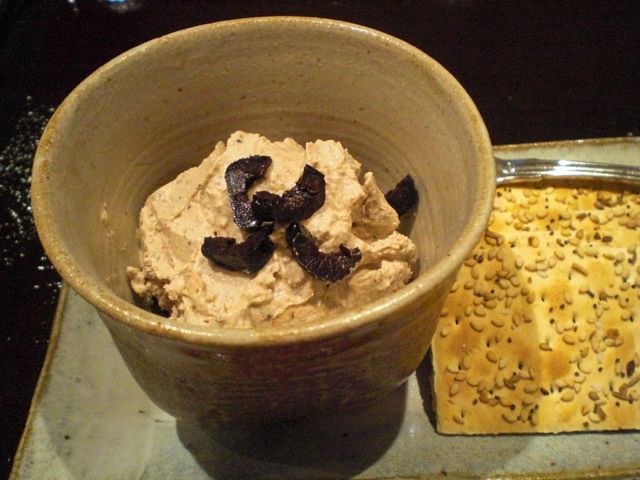
I asked my wife to fill in here.
This is based on the recipe in the book but I made some modifications. Unlike my husband, I followed the recipe. Turned out the initial concoction was too salty to our taste. My husband suggested I add more cream cheese which I did. In addition, I found a log of fresh goat cheese and threw that in too. This made the spread better--his cooking technique tends to be more successful than mine.
This is the recipe I ended up with. The tepanade: 1 cup of mixed black and green olives, 1 garlic clove, 3 anchovies, 2tsp capers, 1-2 tbsp olive oil, black pepper (to taste), lemon juice (to taste), 1 package of 1/3 fat Philadelphia Cream cheese, 1-13 oz. log of goat cheese. Put all the ingredients in a food processor and blend until it forms a smooth puree.
The olive and anchovy's saltiness was diluted by the cheese but we could still taste both the olive and anchovy flavors with just enough saltiness. On a cracker, this goes so well with wine. Of course we were drinking reds with this but probably any white wine would work as well.
Monday, May 14, 2012
Sunset at the restaurant on the beach
We were recently on an island in the Caribbean which has achieved notoriety for the notable disappearance of several young ladies. We are pleased to say that we returned after one week of sun, surf, warm weather and cobalt blue water. It was almost like a real life "ground hog day" experience. Every day much the same as the previous day--same weather, same cobalt blue sea, same fellow in white shorts and tennies greeting us to place our same 4 allotted towels under our allotted palapas (grass huts that provide shade). Having said that, there is no doubt that the beaches are spectacular.
Friday, May 11, 2012
Garlic chive omelet ニラ玉
Japanese really like garic chives or nira ニラ. I see garlic chives rarely in the regular grocery store but, fortunately, we have garlic chives growing in our herb garden and they just emerged for spring. When I told our Japanese landscaper that our garlic chives tend to be tough, he told me to cut them off frequently even if you do not eat what you cut. That way, new teder shoots will keep coming up. So, I am harvesting occasionally even if I do not use it.

As long as you have fresh garlic chives, this is an easy dish. There appears to be two basic styles; for one the eggs just get scrambled with the garlic chives and in the other is to mix the chives and eggs to make a round omelet. The difference may seem subtle but the end result is different in consistency--the round one is almost like a Spanish tortilla. I chose the latter and also made a sauce or "an" 餡.
Japanese think the combination of garlic chives and eggs is particularly good. This dish, "Nira-tama", "nira" means garlic chives and "tama" is short for "tamago" meaning eggs, is one of these dishes and must have a root in a chinese dish.
Fresh garlic chives (one small bunch) chopped into small pieces. I mixed the pieces into the beaten eggs (2 large) and seasoned with salt and pepper (left). In a small no-stick frying pan, I added vegetable oil and sesame oil (1:1 total of about 3 tsp) and cooked it on medum low flame for a few minutes and flipped over (right)
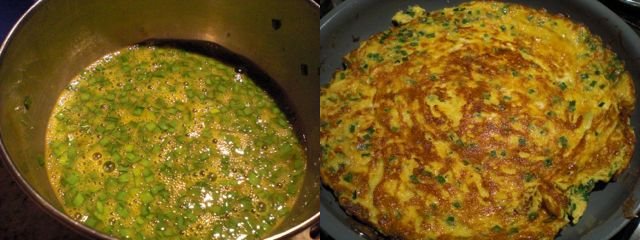
For the sauce, I simply mixed dashi (1/4 cup), soy sauce (1 tbs) and mirin (1 tbs). When it came to a boil, I added a potato starch slurry made with sake (2 tsp) to thicken the sauce. You could add vinegar to make it a sweet and sour sauce or add hot sauce to make it spicy.
I served this as a drinkng snack. This late spring/early summer garlic chives were tender but did not have a strong flavor--it was a classic taste of the season. I served this with asazuke of cucumber, daikon and carrot, blanched broccolini with mustard soy sauce dressing or "Karashi souyu" 芥子醤油.
I served this as a drinkng snack. This late spring/early summer garlic chives were tender but did not have a strong flavor--it was a classic taste of the season. I served this with asazuke of cucumber, daikon and carrot, blanched broccolini with mustard soy sauce dressing or "Karashi souyu" 芥子醤油.
Wednesday, May 9, 2012
Pan fried shad roe with bacon シャド 魚卵のベーコン焼き
My understanding is that shad is type of fish which lives in the ocean (Atlantic in the U.S.) but swims up the river to spawn in spring. I do not think a similar fish exists in Japan. The roe of this fish is more valuable than the fish itself. It is also very seasonal and only appears in fish markets, in March and April. The first time I saw shad roe, I was a bit surprised to learn that Americans eat "fish eggs". As I mentioned before, when I made shrimp roe with scrambled eggs, the classic way to cook shad roe is scrambled with hen's eggs as a breakfast, which was also surprising to me since "fish" or "fishy" food are usually not eaten for breakfast in the U.S.. I mentioned in passing, when I posted simmered cod roe "Tarako", that I could make a similar dish with shad roe.
Speaking of seasonal food or shun 旬 (which is mostly lost since almost everything is available year around), it also applies to "soft shell crab" season. So one evening, on the way home from work, we stopped at the near-by gourmet grocery store and got live (until it was cleaned) soft shell crabs (which was consumed as "tempura" immediately that evening) and shad roe (which was prepared for the next evening and is the subject of this post).

I asked my wife how she likes shad roe to be prepared. She was not keen on the idea of simmering it in the broth in a Japanese style. She told me of how her grandparents looked forward to shad roe season and brought them home with much fan fare mostly to be served with eggs at breakfast but also in the traditional way with bacon. She mentioned that aside from caviar, shad roe were the only fish eggs she had ever eaten before she met me. So in honor of her nostalgia, I cooked these roe American style as you see in the picture above. Shad roe is similar to tarako or cod roe but the eggs are a bit coarser. I panfried it in browned butter and bacon fat and finished it in an oven. As a side I made sautéed shimeji mushrooms and baby spinatch using the remaining bacon fat and butter.

Cooking: I first slowly cooked one strip of bacon in a frying pan (for 7-10 minutes) until the bacon fat was rendered and the bacon became crispy. I set aside the bacon and added a pat of butter (1/2 tbs) and turned up the flame to medium. When the butter melted and started browning, I put the shad roe in and cooked for 2 minutes.Then carefully turned them over (the roe was still soft) and cooked it for another minutes or so until the surface get brown and crispy (another 2-3 minutes). I finished cooking in a 350F oven for 5 minutes. It is important not to over cook. I was aiming for, when pressed, soft but somewhat elastic texture (I read somewhere that this was described as "like a ripe avocado").
For the sides, after I removed the roe and set it aside, I put, in the same frying pan on medium flame, the mushrooms and sautéed them for several minutes seasoned with salt and pepper. I pushed the mushrooms aside and sautéed baby spinach next until wilted (less than 1 minute), again, seasoned with salt and pepper.
Shad roe: I removed the membrane connecting two roe sacks first and then soaked them in cold salted water (taste just salty, 3%??) in a sealable container which can hold the roe sacks comfortably in a refrigerator for over night. You could skip this step but since we were having soft shell crabs that evening, this was a perfect step for us. It removes some of the fishy taste/smell and also brines or seasons it. Next day, I removed them from the salt water and patted them dry using paper towels. I then seasoned them with salt and pepper (left in the picture below). I then dredged with flour.
For the sides, after I removed the roe and set it aside, I put, in the same frying pan on medium flame, the mushrooms and sautéed them for several minutes seasoned with salt and pepper. I pushed the mushrooms aside and sautéed baby spinach next until wilted (less than 1 minute), again, seasoned with salt and pepper.
I sliced the shad roe and garnished with crispy bacon bits and chopped parsley and served with wedges of lemon. I think that any Japanese would like this dish and it will sell in Izakaya. The shad roe has a just slightly fishy taste with a nice consistency (like that of a meatball) and browned butter and bacon fat combination cannot go wrong.
Monday, May 7, 2012
Honey mead 1992 vintage ミード蜂蜜酒1992
Many years ago, I was into making beer (ale, to be exact). My wife was not particularly fond of beer, although she said, my beer was best she ever tasted. Since I had all the brewing apparati (fermentation buckets, air locks, tubings, glass carboys etc), I made mead for a few years (1992 - 95) by her request. Since it tastes better if we give a chance to "mature" we tucked it away and promptly forgot about it. Recently, we were cleaning out the storage area and came upon all the boxes filled with bottles of mead quietly sitting in the dust. Since my first attempt at making mead was vintage 1992 and if it were a kid would be going to college we thought it was time to pop the cork.
Mead must be one of the earliest alcoholic beverages human had on hand. Essentially honey water fermented, which could happen naturally. Although the name "Honey mead" sounds like a sweet beverage, in its original form, it is totally dry since all the sugar is converted to alcohol. Some of the commercial meads are sweet because of the addition of honey or sugar after fermentation.
One of the problems with brewing is contamination which can give rise to off-tastes. Keeping sanitary conditions is very important when fermenting anything, either wine, beer or mead. My understanding is that, in the old days, because off-tastes often developed in mead due to contamination, honey was added to cover up the bad taste which gave rise to "sweet" mead. Mine was done under strict sanitary conditions and is bone dry.
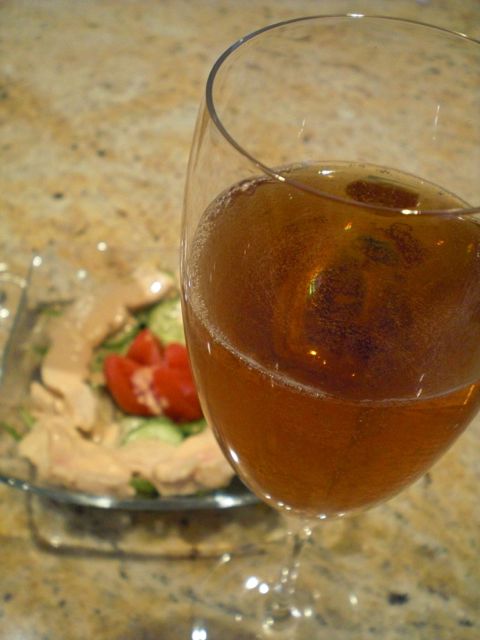
This was a sparkling mead with hops. Apparently, I had easy access to freeze dried quality hops at that time. I do not remember the exact recipe but I must have used a fragrant finishing hop and Champagne yeast which can ferment to a higher alcohol level than ale or wine yeast. After 20 years of bottle aging (I used a beer bottle which was capped with a crown), the bubbles were rather weak but the color was nice dark brown as you can see above.
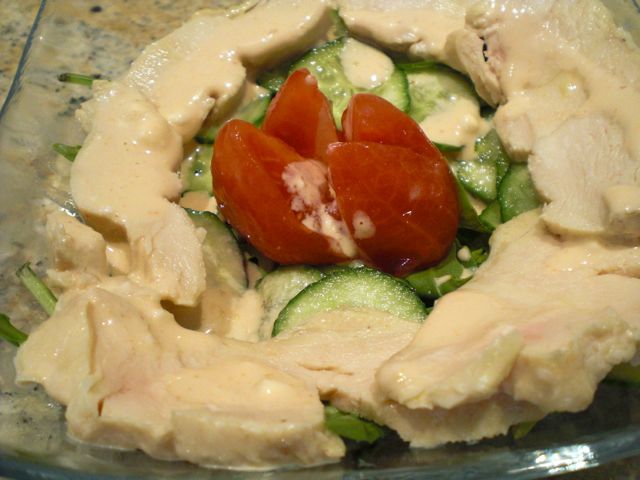
I was amazed that my mead survived for 20 years in our basement (we actually have quite a supply including some bottled in champagne bottles--I must have been quite industrious at one point). I have another batch flavored with raspberries (from 1995, I think) which we should try next. Only problem is, once we drink this supply It will be another 20 year wait for the next batch.
It is dry but the aromatic flavors of the honey was still there. Hops were added because of the taste and as a preservative but at this point, only a very subtle bitterness (which is quite refreshing) remains.
I concocted a quick chicken salad to go with the mead. The chicken was sliced microwave sake-steamed chicken breast. I placed it on a bed of baby arugula with sliced mini-cucumber (salted and extra moisture rung out), a skinned and quartered Campari tomato. The dressing was a mixture of mayonnaise and plain yogurt seasoned with hot sauce (Sriracha) and soy sauce. The proportion of mayo and yogurt is abut 1:1 (2 tbs each), hot sauce (1/2 tsp but this is totally up to your taste) and soy sauce (1/2 tsp). I diluted the mixture with the addition of juice from the chicken container (protein from chicken, salt, sake with flavor of ginger and scallion) but you could just use water to loosen the dressing or you do not have to make it loose. I drizzled the dressing over the salad.
The salad was pretty good. The heat from the hot sauce came on slowly but it is quite pleasant and went well with our mead.
Saturday, May 5, 2012
Sea Urchin pasta with poached egg 雲丹のパスタ温泉卵のせ
When we got sashimi from Catalina, only "premium" uni was available. After three days, one tray was left. Since the premium uni was a bit soft to begin with and the edges were disintegrating a bit (tasted OK, though), I decided to make another version of Uni pasta. I suggested to my wife, Carbonara style or a poached egg on the top. She chose the latter.

There is nothing different from what I posted before except for placing a poached egg on the top. As before, I used angel hair pasta. I added olive oil (or butter) in the frying pan (1 tbs) and added the cooked pasta and cream (3-4 tbs) and heated it up. When the cream was slightly reduced and coated the pasta, I put the uni in the pan (leaving a few aside for garnish) and mixed them with the pasta using a silicon spatula. Then I cut the flame. I tasted it and seasoned it with a bit of salt and pepper and also mixed in finely chopped parsley (Perilla or chives would also have been fine but I did not have them).
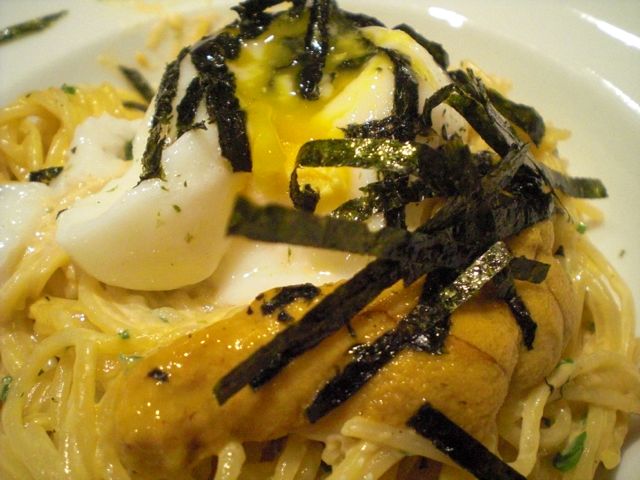
The combination of cream, uni, and egg yolk made this dish ultra rich and creamy. Although I was a bit disappointed with the quality of the sashimi items we received from Catalina this time, this was a quite piece de resistance to finish up the uni.
Porched eggs were made in our usual way with the yolk still runny (using pasteurized shell eggs). I garnished with thin strips of nori.
Thursday, May 3, 2012
Yaktori-style grilling 焼き鳥風グリル
For one reason or another, we have not had a chance to grill outside in Yakitori-style for a long time. Since it was warm, mosquitos were not out (yet), and we regained access to our Yakitori grill, we decided to do an impromptu Yakitori-style grill. Since we did not have much time for preparation, I made a simple grill including;
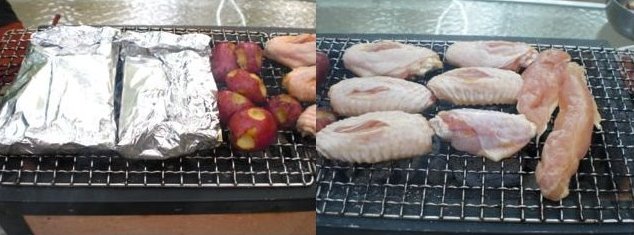
The shimeji was very good with miso and butter flavors (below). As I mentioned before, a similar dish made of enoki mushroom was the dish we enjoyed at the Robatayaki restaurant in San Francisco Japan town in our earlier days.
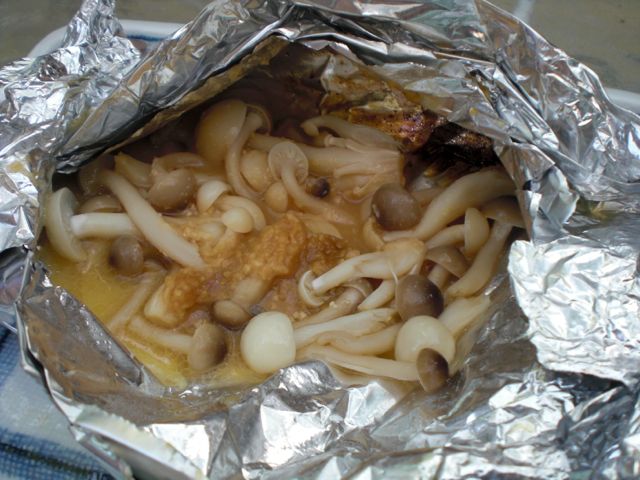
My wife was mashing up the grilled potatoes in this sauce (She even raided my packet since I had some sauce left). The royal trumpet mushroom had a nice firm meaty texture. The chicken parts were all good as expected, although the surface was a bit charred due to the sugar content of the marinade. After finishing the chicken and the vegetables, I also started grilling our perfect grilled rice balls as you can see in the first picture below.
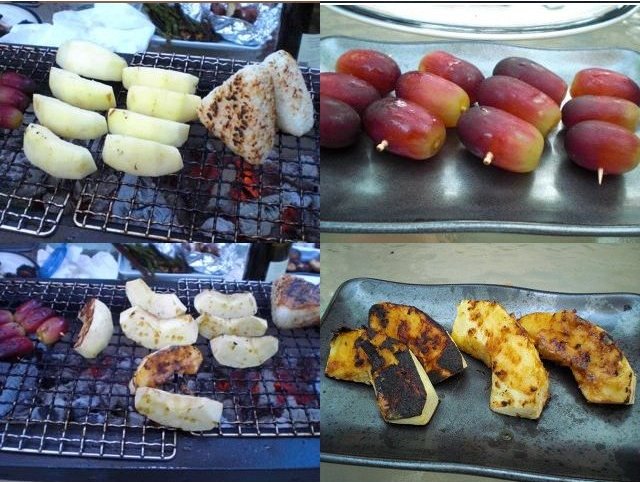
My wife disappeared and brought down some sliced Fuji apples and red seedless grapes on skewers. She suggested I grill them as a dessert (see the picture above). She also suggested that I smear the miso sauce I had used for the chicken tenders and the rice balls on the apples. I have heard of grilling peaches and pineapples but no apples and grapes. (Leave it to my wife to come up with out-of-the-box (grill??) ideas).
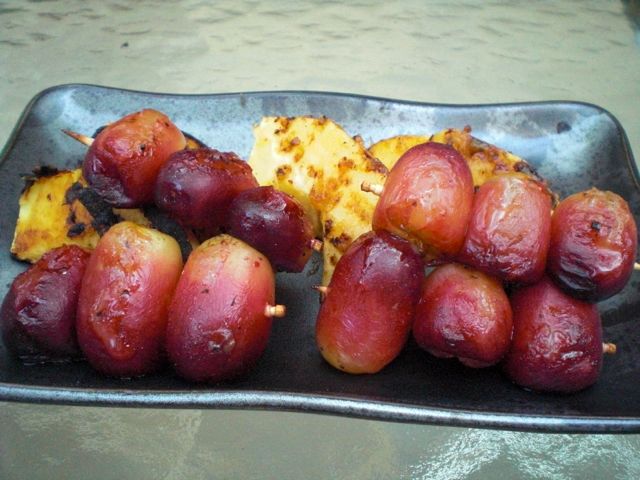
This picture shows a plate of our dessert. The apples were still firm and juicy inside but the surface was caramelized and sweet. The miso added a nutty and slighly salty flavor that was unusual but quite nice. The grilled grapes were new to me. I fully expected them to explode when they were over the fire, but they didn't. Again, the surface got slightly caramelized and the sweetness was enhanced. They went extremely well with the red wine we were drinking. We, as always, enjoyed eating al fresco.
1. Chicken wings and drumetts (marinated in sake, mirin, salt, and Sriracha hot sauce for several hours but I should have just grilled with salt and pepper)
2. Chicken tenders (marinated in sake and salt. After it was almost cooked, I smeared miso sauce - mixture of miso and mirin - and finished cooking).
3. Vegetable: small red potatoes (microwaved and then cut in half, coated with olive oil and salted), Royal trumpet mushrooms (torn lengthwise into 2 to 4 pieces depending on the size and seasoned with soy sauce, sake, mirin and coated with olive oil), and asparagus (coated with olive oil and seasoned with salt and black pepper). We also had shimeji mushrooms in a packet (a pat of butter, miso disolved in sake and mirin with an addition of sugar).
Here, from the left are two shimeji packets, red potatoes, wings, and tender.
Here, from the left are two shimeji packets, red potatoes, wings, and tender.
Tuesday, May 1, 2012
Chicken teriyaki 鶏腿肉の照り焼き
"Teriyaki" 照り焼き was popularized in the U.S. early on as a Japanese dish, probably in the same period "Sukiyaki" was getting popular. It has been incorporated in American home cooking (especially backyard BBQ) and you can buy a bottle of "Teriyaki" sauce (from Kikkoman and others) in any grocery store. I am not sure American-style "Teriyaki" even qualifies as an authentic Japanese dish. Usually, the teriyaki sauce is used as marinade and/or like a BBW sauce for meat. The meat is then grilled.
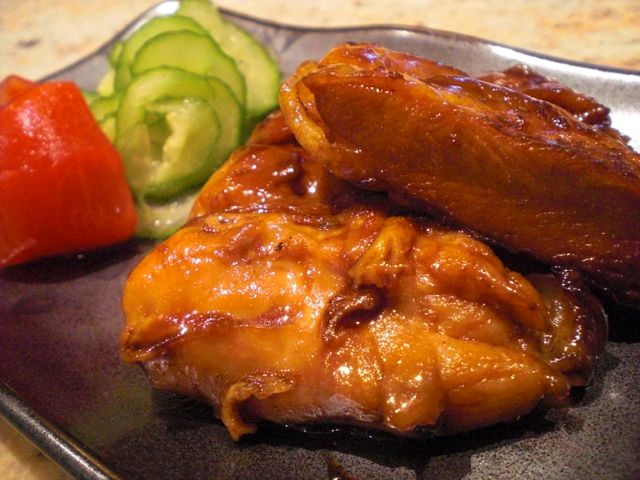
If I am making teriyaki chicken from scratch, I prefer to use thigh meat, deboned but skin on. I butterfly the thickness part to make the entire piece even thickness. I could marinate (mirin and soy sauce or sake and salt) but that is optional. I cook it from the skin side first in a frying pan until the skin is well browned (removing some excess oil by blotting with a paper towel) and cook the other side. In this occasion, I used leftover thigh meat which was salted and grilled (two thighs, that had been grilled in a George Forman's grill) so I skipped this process. Since the chicken was already cooked I went directly to the "saucing" step.
Since this was made from leftover grilled salted chicken, it took less than 5 minutes to make. This was a sort of cannot-go-wrong type of small dish if not exciting. The cinnamon flavor of the Chinese 5 spices came out rather prominently. If you do not like this, stick to "Sansho" powder.
The original Japanese cooking technique of "Teriyaki" is braising not really grilling. "Teri" 照り means glossy surface or luster and "Yaki" 焼き means grilled but "Yaki" in Japanese could mean braised as in "Sukiyaki". So, any dish braised in a sauce (usually soy sauce based with sugar) until the sauce is reduced and thick (due to the sugar content) and coats the surface of the food items is called "Teriyaki" either meat or fish.
I then poured in "Teriyaki sauce"* and put the lid on for a few minutes (in this case, I really did not need to cook the chicken further). With the lid off, I turn up the flame and reduced the sauce until it became thick; clinging to the surface of the chicken giving "teri" or luster to the surface. Just to be slightly different, I sprinkled Chinese 5 spices (or Japanese "sansho" 山椒powder) to finish.
*You could use a bottled one but I just use a mixture of soy sauce and mirin (about 1:1).
Since this was made from leftover grilled salted chicken, it took less than 5 minutes to make. This was a sort of cannot-go-wrong type of small dish if not exciting. The cinnamon flavor of the Chinese 5 spices came out rather prominently. If you do not like this, stick to "Sansho" powder.
Sunday, April 29, 2012
Crispy Pork "Tatsuta" fry 豚肉の唐揚げ竜田揚げ風
This is another small dish I made from the trimmings of pork tender loin. This is a variation of "tatsuta-age" 竜田揚げ but I pounded the pork thin so that the entire thing fries up quickly with a very crispy crust.

This is a perfect starter and is the best just coming out of the hot oil but it is highly seasoned and it tastes good even cold.
Pork: I used trimmings from two pork tenderloins. I cut the trimming into half inch medallion and pounded thin (1/4 inch or less). I seasoned both sides with salt and pepper (easy on salt). I added a small amount of soy sauce and grated ginger and mixed in to the meat.
Dredging four: I used a mixture of potato starch and rice flour (1:1). I dredged each piece of the pork, shaking off excess flour.
Deep frying: I used only half a inch deep vegetable oil but since the meat was very thin, it was deep frying. I fried it in 180C or 350F oil for one minute on each sides turning once.
After draining the oil, I served it with wedges of lemon and microwaved snap pea. Since it is well seasoned with pepper, salt, soy sauce and ginger, there is no need for sauce. You mostly enjoy eating the "crust" than the meat itself. My wife thinks that the leftovers from this dish are a great sandwich item.
Subscribe to:
Posts (Atom)











